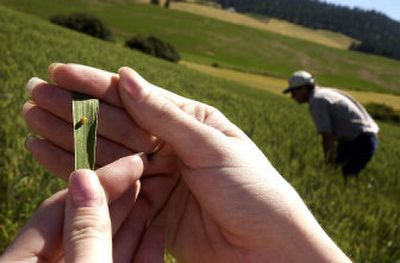Wheat fields are abuzz

Agriculture officials received encouraging news this month about their battle against a prolific and destructive little beetle that feeds on wheat plants.
By releasing millions of small parasitic wasps at several Spokane County farms, Washington State University extension agents think they may have turned back an onslaught of cereal leaf beetles before it became an infestation.
The highest stakes in this bug fight belong to farmers. If the wasps – euphemistically called “biological controls” – are not successful at slowing the beetles, wheat growers might have to routinely spray insecticides across their fields. That’s expensive – perhaps $12 to $13 an acre – and less desirable because the indiscriminate sprays also kill good insects such as ladybugs, said WSU extension agent Diana Roberts.
The adversaries are tiny beetles that reproduce by the thousands and lay their eggs on wheat plants. When the eggs become larvae, they begin eating the green chloroform on wheat leaves, which cripples the plants’ ability to grow and produce good kernels.
The two species of wasps released by extension workers lay their own microscopic eggs into the beetles’ eggs and larvae. When the wasps hatch, they become parasites and feed on the immature beetle, eventually killing it before it can grow into an adult and reproduce.
Today there are potentially tens of millions of these wasps buzzing through wheat fields in search of the cereal leaf beetles.
Don’t worry though, Roberts says: these wasps are not the pesky sort that plague picnics and deliver painful stings. Rather, these are black little bugs, less than 1/8-inch long that could care less about people and pets in their search for beetles.
The entire episode involves non-native species.
The beetles are native to Eurasia. So are the two types of tiny wasps that prey on them. For that matter, the wheat that grows across Eastern Washington originated, like most cereal grains, from that region, Roberts said. It creates a dynamic Eurasian grain-field ecosystem within the larger Inland Northwest region.
The beetles prefer cereal crops. And the wasps prefer the beetles. Neither is considered a threat to native, North American bugs and plants. That’s a good thing, Roberts said, considering that both are now here for good.
Peone Prairie farmer Mark Hauschild noticed one of his fields last year had a silvery tint. He wondered what could be going on and then remembered a warning about the cereal leaf beetles. He confirmed his suspicions and ended up spraying to save his crop.
“I didn’t have much choice,” he said.
Just a few miles down the road, meanwhile, Roberts had released wasps.
So this year when Hauschild noticed some problems in a field, he called Roberts first.
She assigned a couple of field assistants, Kathlene Peck and Lacey Jones, to collect some beetle larvae from the wheat field and look for the microscopic evidence of wasps.
Sure enough, more than 75 percent of the beetle larvae gathered from the field have been being parasitized by wasps.
Roberts, with a big grin breaking across her face during a visit to the wheat field this week, is thrilled with the results.
“This is far better than I anticipated,” she said. Indeed, the small wasps have spread from their release point to find and attack beetle concentrations very quickly.
The first cereal leaf beetles found in the United States were on a Michigan farm in 1962. It took the insect 37 years to arrive in Eastern Washington. Once here, the beetles, free from parasitic wasps, gorged on regional wheat fields.
Now that has all changed, and Roberts ultimately hopes farmers will not have to resort to spraying their fields.
“We know we’re asking a lot of farmers; to take a hit for a few years and give these wasps a chance to establish … but we think it will work,” she said.
At the very least, she hopes farmers will not spray entire fields, allowing the wasps to continue expanding into more parts of the state, following cereal leaf beetles from field to field.
If successful, the wasp and beetle populations will rise and fall together like other predator-prey pairs.
The beetles have been reported in most Eastern Washington counties and North Idaho.
There are active wasp release programs near Colville, Ritzville, Warden, Moses Lake, Connell, Walla Walla, Deep Creek and Nine Mile.